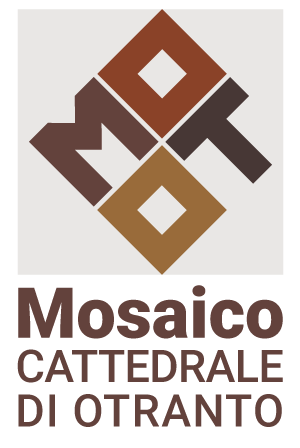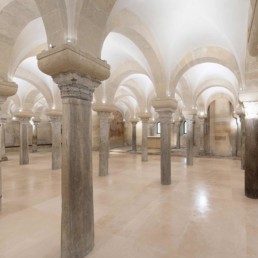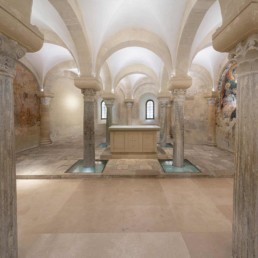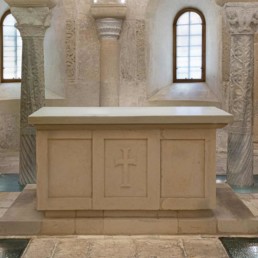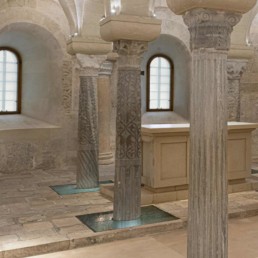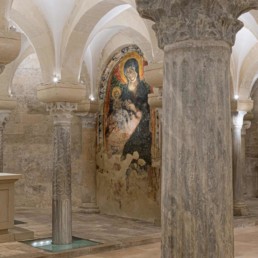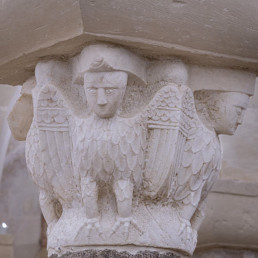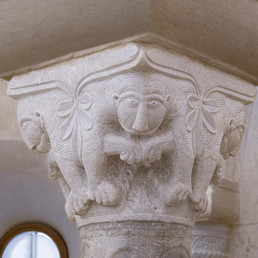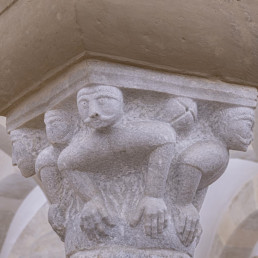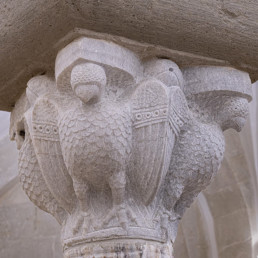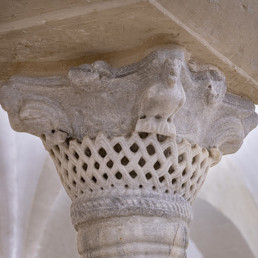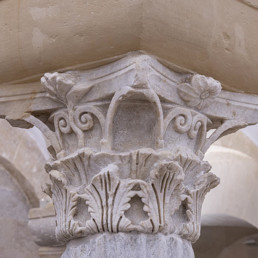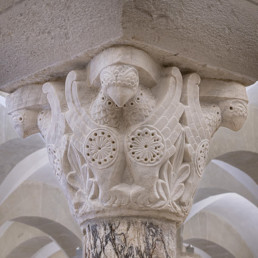The crypt
A gem within a gem
The crypt, which almost certainly dates back to before the 11th century and which brings to mind the world-renowned Yerebatana cistern of the Basilica of Constantinople (the Hagia Sophia), is of significant artistic and historic value, so much so that it is considered an architectural gem within an architectural gem.
The space extends underneath the apse for the full length of the transept of the above-ground part of the Basilica, the aisles of which are connected to the crypt by wide staircases.
Unlike standard crypts, which are completely subterranean and devoid of any natural light, the crypt of the Cathedral of Otranto rises about a metre above street level and is lit directly by five windows.
The crypt also features an external access door, opened for liturgical needs with the authorisation of the Archaeological Heritage Department in 1987 when restoration work on the mosaic began.
The structure
Discovering the vaults, columns and frescos
The crypt contains 48 cross vaults, supported by 42 monolithic columns in raw or polished marble of various sizes and qualities.
The columns, recovered from old buildings from around the region, are arranged in four rows; another 23 semi-columns are positioned against the perimeter walls and support the aforementioned vaults.
Attention must be given to the artistic value of the various capitals, which can be dated chronologically from late Antiquity to the early Romanesque period and which depict a range of different figures.
The variety of the iconography includes Christian symbols (crosses), plant motifs (acanthus leaves, racemes, palm leaves), anthropomorphic figures, animals (birds, lions, eagles), and monsters (harpies).
The shafts of the columns also differ in style and quality of marble.
The diverse range of columns and the exceptional combination of capitals that distinguish each of them are not random, but have been deliberately chosen.
The Corinthian, Ionic Asiatic, Egyptian, Islamic, Lebanese, Byzantine and Persian capitals would have allowed foreign pilgrims to see something of their own culture in Otranto by recognising the style most familiar to them. As a result, they would not have felt foreign in a strange land, but rather at home (as would have happened to them upon seeing the mosaic).
Those of particular interest include:
• the Islamic capital, considered one of the most beautiful in the entire crypt, which is decorated with half-lion figures on the edges separate by elongated hanging palm leaves.
• the Late Antiquity capital, with horses and atlantes.
• the Byzantine capital, with an all-seeing eye and four eagles.
• the Persian capital, with side-by-side eagles, two on each side, merging up into a single head.
• the Egyptian capital, with the all-seeing eye, dating from the 6th to 7th centuries
Just the like the walls of the cathedral, the walls of the crypt would have been richly decorated with frescoes.
We can only imagine what this subterranean space must have looked like with its fully decorated walls.
The wall paintings were destroyed in 1480 when the Ottomans besieged and took Otranto and turned the cathedral into a mosque. This resulted in the destruction of every representation of a human figure in the cathedral, with only the fresco depicting the Virgin Hodogetria (11th century) and Christ the Master (13th century) of the Italo-Greek school, both important links between Byzantine art, a style that dominates this part of Italy, and Italic art.
Frescoes depicting local saints were either covered up or destroyed, only a few of which remain to this day, including St Nichols in the left-side apse, and the Nativity and St Francis receiving the Stigmata, which can be admired along the wall by the cathedral’s entrance.
